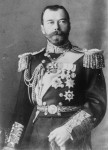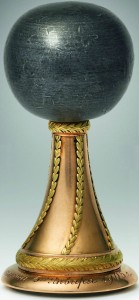 St. Petersburg, Epiphany Day, January 6th (January 19th on the Gregorian calendar), 1905: Tsar Nicholas II, members of the royal family and diplomatic corps attend the ceremonial blessing of the waters of the Neva River in front of the Winter Palace. This is a longstanding tradition celebrating the baptism of Christ in River Jordan transposed to a frigid Russian winter setting. A hole called the Jordan is cut in the ice of the river and the Russian Orthodox Metropolitan of Saint Petersburg immerses his cross in it, blessing and purifying the water. People flock to collect the holy water which is believed to have protective and curative powers.
St. Petersburg, Epiphany Day, January 6th (January 19th on the Gregorian calendar), 1905: Tsar Nicholas II, members of the royal family and diplomatic corps attend the ceremonial blessing of the waters of the Neva River in front of the Winter Palace. This is a longstanding tradition celebrating the baptism of Christ in River Jordan transposed to a frigid Russian winter setting. A hole called the Jordan is cut in the ice of the river and the Russian Orthodox Metropolitan of Saint Petersburg immerses his cross in it, blessing and purifying the water. People flock to collect the holy water which is believed to have protective and curative powers.
The Tsar and some of the dignitaries observe the blessing from an elegant pavilion built overlooking the river, while the Tsarina, Grand Duchesses and members of the diplomatic corps watch from the windows of the Winter Palace. The blessing is marked with a military gun salute.
 This year, however, the ceremonial gun salute has an unexpected bite. The 17th Battery of the First Horse Artillery of the Guard, one of the most aristocratic of corps in the Russian army, firing from Vasilyevsky Island in response to shots from the Peter and Paul Fortress, has among all the blank saluting cartridges at least one weapon loaded with live ammunition. That gun happens to be aimed right at the Imperial pavilion. A charge of grapeshot peppers the Jordan, injuring one police officer and snapping the flagpole of the Marine standard. The shot also breaks four windows in the Window Palace, where the Tsarina and company stand. Nobody is harmed, but the Tsar’s mother is sprinkled in broken glass.
This year, however, the ceremonial gun salute has an unexpected bite. The 17th Battery of the First Horse Artillery of the Guard, one of the most aristocratic of corps in the Russian army, firing from Vasilyevsky Island in response to shots from the Peter and Paul Fortress, has among all the blank saluting cartridges at least one weapon loaded with live ammunition. That gun happens to be aimed right at the Imperial pavilion. A charge of grapeshot peppers the Jordan, injuring one police officer and snapping the flagpole of the Marine standard. The shot also breaks four windows in the Window Palace, where the Tsarina and company stand. Nobody is harmed, but the Tsar’s mother is sprinkled in broken glass.
The official story is that this was negligence, an accident caused when the artillery was not properly cleaned after target practice two days earlier. It’s not a satisfying explanation. The guns can only take a single charge at a time, so how come nobody noticed there was already something in there when they attempted to charge the saluting cartridges on the day of the ceremony? Also, ceremonial salutes aren’t generally aimed right at the Emperor.
On the other hand, any artillery expert would know that grapeshot is not an effective tool of assassination when it has to cross a river to reach its intended target. If one of the soldiers of the battery had been attempting the life of the Tsar, surely he would have loaded the gun with something that had a chance of working. One the lead pellets lands not three feet away from the Tsar, but it’s unlikely it would have harmed him beyond a contusion had it made contact.
 Nicholas seems sanguine about the event in his diary, but an investigation is launched into the disturbing event. Several officers are court martialed two months later and convicted of negligence, but no evidence of conspiracy or intent to harm is presented at trial.
Nicholas seems sanguine about the event in his diary, but an investigation is launched into the disturbing event. Several officers are court martialed two months later and convicted of negligence, but no evidence of conspiracy or intent to harm is presented at trial.
Grand Duke Nicholas Nicholaievitch, grandson of Nicholas I and first cousin once removed to Nicholas II, is standing next to the Tsar when the shot reaches the pavilion. He picks up one of the lead pellets and gives it to Carl Fabergé, the imperial family’s favorite goldsmith, to have a memento made of the near miss. Fabergé mounts the lead shot, a pristine lead ball 1.5 inches in diameter, on a gold seal 2.5 inches high. In the base he sets a white chalcedony sealing stone engraved with the personal crest of the Tsar. The Grand Duke gives it to Nicholas as a present.
When revolution breaks out, a courtier takes the seal with him as he flees the country. It remains privately held for close to a century. Now, for the first time, the shot that missed the Tsar is being offered for sale by jewelers and Fabergé specialists Wartski of London. The suggested retail price is £500,000 ($760,000). It will go on display at the TEFAF art fair in Maastricht from March 15th to 24th.

